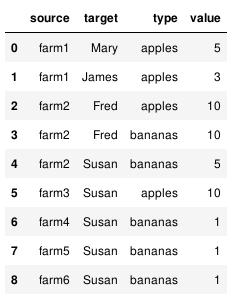
by Rick Lupton and Contributors
Many kinds of data can be thought of as 'flows': energy and materials moving through industry, money flowing through the economy, telephone lines moving between providers, voters moving between parties. floWeaver helps you to exchange and analyse flow data and visualise it using Sankey diagrams.
For example, here is some data on flows of fruit from farms to customers:
With floWeaver you can visualise this as a variety of Sankey diagrams depending on what you want to show:
Although there are a variety of tools for working with flow data and Sankey diagrams in particular contexts, there are no open data formats for sharing data between tools and domains. We aim to provide a common data format and data converters to support interoperability and open data.
You are free to copy, modify, and distribute floWeaver with attribution under the terms of the MIT license. See the LICENSE file for details. If you find it useful please acknowledge that by citing floWeaver (see below).
floWeaver is a Python package, but you can successfully use it as a data analysis tool even without too much familiarity with Python. The best way to get started is to use it in a Jupyter notebook (although it is just a Python package, so you are free to use it however you wish).
🚀 Try floWeaver online with no installation: Quickstart tutorial.
To install floWeaver locally, you need Python 3 installed (you might want to install it using Anaconda or Miniconda); see the installation page for full details.
Install floweaver using pip:
pip install floweaverYou likely also want the ipywidgets and ipysankeywidget packages to show Sankey diagrams in the Jupyter notebook. Install this using pip and enable:
pip install ipysankeywidget
jupyter nbextension enable --py --sys-prefix ipysankeywidgetipywidgets also needs to be enabled. You might have already done this, but missing it out is a common cause of problems so it doesn't hurt to do it again!
jupyter nbextension enable --py --sys-prefix widgetsnbextensionTo get started, open the quickstart tutorial in Jupyter notebook and step through the notebook cells to produce the fruit example shown above.
Tutorials, cookbook examples, and API documentation are all available on ReadTheDocs
If you have a question that isn't answered please open an issue on GitHub, if there isn't one there already. You can also use the Gitter chatroom for discussion and questions.
Thanks for your interest in contributing! There are many ways to contribute to floWeaver: sharing examples of work done using it, suggestions for improving the documentation, examples of things that are more difficult than they should be or don't work, as well as actual fixes to code and documentation. To get started see CONTRIBUTING.md and our code of conduct.
We have a detailed Roadmap showing what we are working on up to May 2018; beyond that there is the longer-term Roadmap. We also have good first issues grouped by type of contribution.
floWeaver builds on the approach described in the paper Hybrid Sankey diagrams: Visual analysis of multidimensional data for understanding resource use. It uses ipysankeywidget and d3-sankey-diagram for actually drawing the Sankey diagrams.
If floweaver has been significant in a project that leads to a publication, please acknowledge that by citing the paper linked above:
R. C. Lupton and J. M. Allwood, ‘Hybrid Sankey diagrams: Visual analysis of multidimensional data for understanding resource use’, Resources, Conservation and Recycling, vol. 124, pp. 141–151, Sep. 2017. DOI: 10.1016/j.resconrec.2017.05.002
and/or citing the software itself; you can get a citation of the latest version from Zenodo.
- Leo Paoli (documentation)
- Konstantin Stadler (issues & use in IOA)
- Dhanuka Lakshan
- Andreas Fehlner
- Elliott Sales de Andrade
- @abmakko (the logo)


